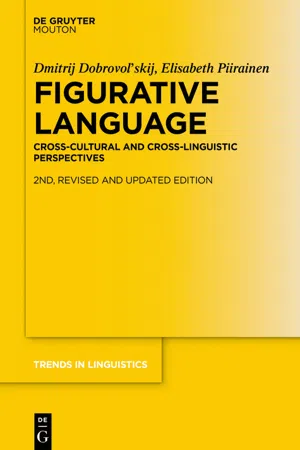
Figurative Language
Cross-Cultural and Cross-Linguistic Perspectives
- 503 pages
- English
- PDF
- Available on iOS & Android
Figurative Language
Cross-Cultural and Cross-Linguistic Perspectives
About this book
The book develops a Theory of the Figurative Lexicon. Units of the figurative lexicon (conventional figurative units, CFUs for short) differ from all other elements of the language in two points: Firstly, they are conventionalized. That is, they are elements of the mental lexicon – in contrast to freely created figurative expressions. Secondly, they consist of two conceptual levels: they can be interpreted at the level of their literal reading and at the level of their figurative meaning – which both can be activated simultaneously.
New insights into the Theory of Figurative Lexicon relate, on the one hand, to the metaphor theory. Over time, it became increasingly clear that the Conceptual Metaphor Theory in the sense of Lakoff can only partly explain the conventional figurativeness. On the other hand, it became clear that "intertextuality" plays a far greater role in the CFUs of Western cultures than previously assumed.
The book's main target audience will be linguists, researchers in phraseology, paremiology and metaphor, and cultural studies. The data and explanations of the idioms will provide a welcome textbook in courses on linguistics, culture history, phraseology research and phraseodidactics.
Frequently asked questions
- Essential is ideal for learners and professionals who enjoy exploring a wide range of subjects. Access the Essential Library with 800,000+ trusted titles and best-sellers across business, personal growth, and the humanities. Includes unlimited reading time and Standard Read Aloud voice.
- Complete: Perfect for advanced learners and researchers needing full, unrestricted access. Unlock 1.4M+ books across hundreds of subjects, including academic and specialized titles. The Complete Plan also includes advanced features like Premium Read Aloud and Research Assistant.
Please note we cannot support devices running on iOS 13 and Android 7 or earlier. Learn more about using the app.
Information
Table of contents
- Preface
- Acknowledgements
- Contents
- 1 General issues
- 2 Conventional figurative language and phraseology
- 3 On the cross-linguistic equivalence of idioms
- 4 Motivation of conventional figurative units
- 5 “False friends” and paronyms
- 6 The Cognitive Theory of Metaphor
- 7 Idioms of Fear: A cognitive approach
- 8 Cognitive modelling of figurative semantics
- 9 Specific frames: The concept House in language and culture
- 10 Culture and figurative language
- 11 Cultural symbolism in figurative language
- 12 Numeral words and number symbols in culture and language: Case studies
- 13 Animal metaphors and animal symbols: Case studies
- 14 Conclusions
- References
- Abbreviations
- Subject index